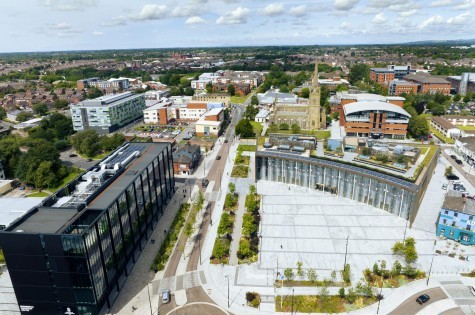Crow Wood, the multi-award-winning hotel and spa resort in Burnley, is striding towards a greener future with the creation of a solar farm on its grounds.
The 1MW farm, with its 2,200-plus solar panels generates enough clean energy to power around 350 homes annually. It is all about on-site self-sufficient, renewable energy delivering commercially for the venue – the kind of investment the government needs to help meet its net zero targets.
Oliver Brown, managing director at Crow Wood, says: “With rising energy use from facility investments and market conditions, this was a
strong long-term investment and a good Corporate Social Responsibility initiative that resonates.”
The government has vowed to cut red tape and to make changes to the planning system to make it easier for projects like this to get off the drawing board. The aim is to drive growth and promote the nation’s low carbon transition.
Oliver says the Crow Wood solar project, which went live last year, wasn’t without its challenges during the planning process.
He says the initial feedback from the council’s planning department was that it could not support the scheme – despite a smaller solar operation already generating electricity on site.
Officers also said that no community benefits had been presented in the planning application.
Added to all that a neighbouring local authority also raised objections.
It needed the input of expert consultants hired by the business to argue the case for the project and to stress that it was in keeping with national government policy.
Oliver says: “Once our consultants argued the misinterpretation of the National Planning Policy Framework, the planning department changed
its view and recommended it for approval, yet it still was not unanimously approved when it went before the planning committee.”
He adds: “The government message is we should all be doing more in terms of sustainability and clean energy, but when you get into it, it isn’t that straightforward.
“We were trying to put together a million pound deal with another Burnley business which seemed to tick all the boxes. It was extremely frustrating.”
There is no doubt the government is in the mood for change. Those in the industry calling for more reforms say planning rules, grid connection delay and inconsistent local authority approaches are all acting as brakes on momentum.
They add that self-generation – producing electricity or heat at the point of use rather than relying solely on the national grid – is moving from an environmental “nice-to-have” to a commercial necessity.
Businesses are taking a serious look at generating power on-site. Solar PV installations, small-scale wind, and combined heat and power (CHP) can significantly reduce exposure to grid prices while delivering measurable carbon savings.
However, while the technology is proven, the journey, as Oliver Brown has indicated, is sometimes less straightforward.
In England, onshore wind developments have been effectively hamstrung since 2015, when changes to planning policy made it harder to gain approval.
Grid connection queues mean that some projects are stalled, waiting to connect to the network even when the infrastructure exists nearby.
And permitting processes for large ground-mounted solar installations vary between local authorities, leading to unpredictable timelines and costs.
Blackpool headquartered energy efficiency specialist Trident believes the solution to all this lies in “joined-up thinking” between policymakers, regulators, and the private sector.
Managing director Michael Dugdale says: “We need a system that prioritises generation projects, creates easy pathways for rooftop solar, and reopens the door for onshore wind.
Without this, the UK risks missing both its net zero milestones and the opportunity for genuine energy resilience.”
On a larger scale, plans for England’s first major onshore wind farm in a decade were submitted in July.
Industry-watchers and communities in the area await with interest how the planning process will pan out in the new era.
Global renewable energy investor Cubico is looking to develop Scout Moor II, on land located on the South Pennine Moors between
Rossendale and Rochdale.
If approved, the wind farm would generate up to 100MW of clean electricity from 17 turbines, enough to power around 100,000 homes each year. That’s equivalent to around 77 per cent of all households in Rossendale and Rochdale combined.
It would be the largest new onshore wind development in England and the first of its kind to come forward since the planning rules were changed to support new projects.
Peter Rowe, development manager at Cubico, says: “Scout Moor II is a chance for Rossendale and Rochdale to lead the UK into a clean energy future – creating jobs, supporting the local economy and backing Britain by producing secure, homegrown energy.
“We’ve been listening closely to what people have told us during the consultation process, and we’re incredibly grateful to everyone who
has taken the time to engage with us. Their input has shaped a stronger scheme that we believe delivers for local communities and
supports national energy goals.
“We understand that new developments like Scout Moor II raise important questions, and that local communities must see real and
lasting benefits. We’re committed to working closely with the council, community groups and residents as the process moves forward.”
Henri Murison, chief executive of the Northern Powerhouse Partnership, says the importance of the project getting the green light cannot be underestimated.
He says: “Research by Cambridge Econometrics has shown we need around £7bn a year of private sector investment in energy generation technologies across the north if we’re to meet future energy demand, create skilled jobs in supply chains, and fulfil our Net Zero commitments.
“This project will help meet the growing electricity needs of both Lancashire and Greater Manchester over the coming decades
to charge electric vehicles, power heat pumps, and support industry.
“As seen in similar projects across the north and in this project specifically, it is possible to strike the right balance between the concerns of local communities and protecting nature while delivering the energy infrastructure we all depend on.”
There will be local opposition. A group calling itself ‘Say No to Scout Moor II’ writes on its website: “We have serious concerns about the
Cubico proposal for the development of 17 wind turbines with a maximum blade tip height of 180m on our beautiful moorland landscape.
“Two major wind farm developments were rejected for 115m and 125m turbines due to their impact on heritage assets. They would also have severely impacted the environment, views, amenity and enjoyment of the area.
“As such, it is difficult to see how planners would accept a much larger proposal. However, mindful of changes in national planning policy, we must be vigilant and fight this aggressive application.”



















